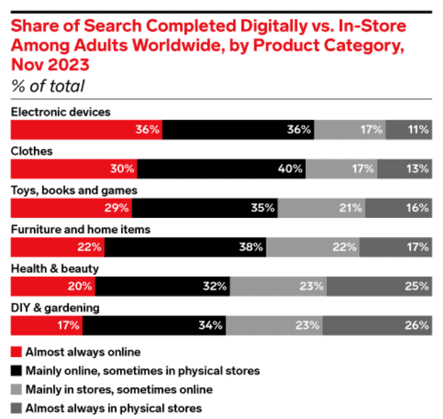
6 Essentials for Your Ecommerce Search Bar
Globally, there are over 5 billion internet users and shopping is a big part of what we’re all doing when we go online. Statista reports that retail ecommerce sales will surpass $6 trillion this year, a number that’s expected to grow.
Searching for products online has become an integral part of the consumer shopping journey, even when that journey ends in a physical store. In another survey conducted by eMarketer, 72% of global consumers said they prefer searching for most non-grocery-related items digitally. Top categories ripe for digital product search include electronics, clothes, toys, books, & games, furniture, and well, just about everything else. Here’s the breakdown by category from eMarketer:
Source: eMarketer
eMarketer notes that while consumers often start a product search online, physical stores still factor largely into purchasing. The data underscores consumers’ reliance on digital search and the all-important ecommerce search bar.
What is an Ecommerce Search Bar?
An ecommerce search bar is a starting point for product search on retail websites, shopping apps, and marketplaces like Amazon. Its role is to help shoppers find products quickly.
The search bar is usually presented as a box or field where users can input keywords or phrases related to the items they’re looking for. Modern search bars can include features like autocomplete, visual results, and personalized search results that connect shoppers to relevant products faster than keyword search alone.
Ecommerce Search Bar Optimization Techniques
Optimizing your ecommerce search bar goes far beyond making it stand out on the page. Amazon and other market-dominating retailers like Walmart and Wayfair provide search bar experiences that focus on intelligent product discovery with features like multimodal search (searching for products using both text and images), personalized product suggestions, and surfacing previously purchased items for easy reordering.
Search bar optimization is focused on guiding shoppers to what they need, are interested in, or didn’t know they wanted. The following search bar best practices are focused on helping you turn ecommerce search into a powerful engine for search personalization and product discovery.
1. Implement Personalized Search Results
Personalized search engines tailor results to each user’s unique preferences and behaviors. They use AI and machine learning to analyze data from current browsing sessions, past purchases, and contextual factors like location or time of day. Some intelligent search technology also uses natural language processing (NLP) to understand the intent behind a user’s search.
Personalized search platforms like Monetate use NLP to interpret user searches even when they’re misspelled or don’t include the exact brand or product name. This enables them to fetch relevant results based on customer context and data. For example, an adult female customer searching for “best rain jackets” might get a selection of women’s rain parkas based on her buying history while someone who frequently buys kids’ clothing might see a selection of child-sized rain slickers for the same query.
2. Use NLP to Understand People-Speak
As we touched on above, NLP is an important aspect of personalized search. It enhances and elevates the search experience by interpreting the context and intent behind user queries. NLP can understand nuances in the ways we, as humans, search for things – this includes synonyms, misspellings, and colloquial terms.
Thanks to NLP, a search engine can distinguish between “dress shirt” and “shirt dress,” then produce accurate results based on the context of these queries. When NLP is integrated into a personalized search platform like Monetate, it aids in product discovery by facilitating natural language search including interactions with chatbots or virtual assistants.
3. Offer Autocomplete and Predictive Suggestions
Autocomplete and predictive suggestions are two features that connect shoppers to the right products quickly. Real-time query completions, a.k.a., “autocomplete”, make suggestions to users as they type words into the search bar. For example, if a user types “sun,” the search bar might suggest “sunglasses,” “sunscreen,” or “sundress”.
Predictive suggestions show popular or trending items as a shopper searches. When paired with autocomplete, this is an effective way to facilitate product discovery. Intelligent search engines use data and ML to come up with the right products based on the context of a user’s search combined with other data points like popular searches, current trends, the user’s own browsing history.
5. Enhance Mobile Search Experience
Mobile commerce, or mcommerce, sales reached approximately $491 in the U.S. in 2023, and are expected to reach about $856 billion in the next four years. With more shoppers using smartphones for online purchases, mcommerce is increasingly informing the design and usability of the search bar.
Mobile-friendly search puts the mobile search bar front and center on your website or app. It should be obvious, responsive, and designed for touch interactions. Features like voice search, visual search, and simplified filtering options can significantly improve usability on smaller screens. Make autocomplete suggestions and search results easily tappable and readable on mobile devices too, since this reduces user frustration and connects shoppers to the products they want more quickly.
5. Incorporate Visual Search Elements
Don’t discount the importance of visual cues when it comes to the search bar itself. Shoppers won’t use your search tool if they can’t find it. Make your search bar visually prominent by using contrasting colors, clear borders, and a magnifying glass icon.
Place it in the header or at the top of your homepage where it’s immediately visible – this also helps with search accessibility, as we expand on below. Use a clean, simple design that stands out from other page elements. You can also include visual cues like placeholder text or a search button. These visual enhancements can significantly increase search bar usage which, after all, is what helps them find what they need.
6. Ensure Search Accessibility for Users with Disabilities
Everyone who visits your website should feel welcome and find the experience rewarding. Prioritizing accessibility for users with disabilities ensures that they find what they need quickly and with minimal frustration.
A well-designed search bar checks many of the boxes needed for online accessibility – clear visual cues, consistent and obvious placement, and high-contrast colors. But the search bar should also be compatible with screen readers, have large-touch targets to help visually impaired users, and alt text for all images. Keep forms brief and form fields in a logical order and use the <label> element for text input fields.

How Can Optimizing My Ecommerce Search Bar Increase Sales?
Ecommerce search is a powerful tool for boosting sales. When you put thought into the design and functionality of your ecommerce search bar, it acts is a like a virtual sales associate, guiding shoppers to products they want – or will want once they know about them. A customized approach that uses personalized search is what resonates with shoppers and motivates them to buy. It’s also what contributes to higher conversion rates and increased average order values.
A personalized search platform like Monetate supports search bar optimization with AI and machine learning that analyzes user behavior and can adjust results based on real-time cues. Shoppers find relevant products in the moment, they find them fast, and they have a more satisfying shopping experience. Reduced frustration from effective product search means customers are less likely to ditch their shopping cart in the middle of a spree. Monetate’s NLP capabilities also make searches more intuitive and user-friendly.
By focusing on accessibility and mobile optimization, you’re expanding your reach to all potential customers. Remember, a smooth search experience often translates to a completed purchase, directly impacting your bottom line.
